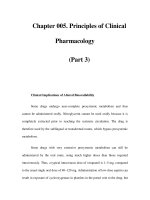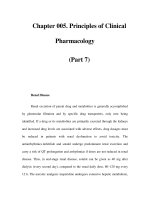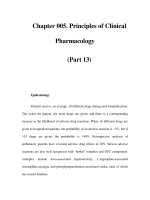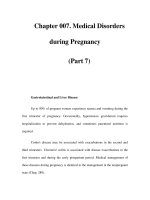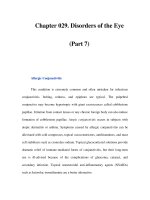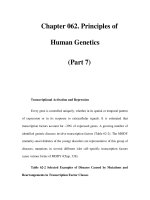Chapter 105. Malignancies of Lymphoid Cells (Part 7) docx
Bạn đang xem bản rút gọn của tài liệu. Xem và tải ngay bản đầy đủ của tài liệu tại đây (16.3 KB, 5 trang )
Chapter 105. Malignancies of
Lymphoid Cells
(Part 7)
Table 105-6 presents the best documented translocations and associated
oncogenes for various subtypes of lymphoid malignancies. In some cases, such as
the association of the t(14;18) in follicular lymphoma, the t(2;5) in anaplastic large
T/null cell lymphoma, the t(8;14) in Burkitt's lymphoma, and the t(11;14) in
mantle cell lymphoma, the great majority of tumors in patients with these
diagnoses display these abnormalities. In other types of lymphoma where a
minority of the patients have tumors expressing specific genetic abnormalities, the
defects may have prognostic significance. No specific genetic abnormalities have
been identified in Hodgkin's disease other than aneuploidy.
Table 105-6 Cytogenetic Tr
anslocation and Associated Oncogenes
Often Seen in Lymphoid Malignancies
Disease Cytogenetic
Abnormality
Oncogene
CLL/small lymphocytic
lymphoma
t(14;15)(q32;q13) —
MALT lymphoma t(11;18)(q21;q21) API2/MALT,
BCL-10
Precursor B cell acute
lymphoid leukemia
t(9;22)(q34;q11) or
variant
t(4;11)(q21;q23)
BCR/ABL
AF4, ALLI
Precursor acute lymphoid
leukemia
t(9;22)
t(1;19)
t(17;19)
BCR, ABL
E2A, PBX
HLF, E2A
t(5;14) HOX11L2,
CTIP2
Mantle cell lymphoma t(11;14)(q13;q32) BCL-1, IgH
Follicular lymphoma t(14;18)(q32;q21) BCL-2, IgH
Diffuse large cell
lymphoma
t(3;-)(q27;-)
a
t(17;-)(p13;-)
BCL-6
p53
Burkitt's lymphoma,
Burkitt's leukemia
t(8;-)(q24;-)
a
C-MYC
CD30+ Anaplastic large
cell lymphoma
t(2;5)(p23;q35) ALK
Lymphoplasmacytoid
lymphoma
t(9;14)(p13;q32) PAX5, IgH
a
Numerous sites of translocation may be involved with these genes.
Note: CLL, chronic lymphoid leukemia; MALT, mucosa-
associated
lymphoid tissue; IgH, immunoglobulin heavy chain.
In typical B cell CLL, trisomy 12 conveys a poorer prognosis. In ALL in
both adults and children, genetic abnormalities have important prognostic
significance. Patients whose tumor cells display the t(9;22) have a much poorer
outlook than patients who do not have this translocation. Other genetic
abnormalities that occur frequently in adults with ALL include the t(4;11) and the
t(8;14). The t(4;11) is associated with younger age, female predominance, high
white cell counts, and L1 morphology. The t(8;14) is associated with older age,
male predominance, frequent CNS involvement, and L3 morphology. Both are
associated with a poor prognosis. In childhood ALL, hyperdiploidy has been
shown to have a favorable prognosis.
Gene profiling using array technology allows the simultaneous assessment
of the expression of thousands of genes. This technology provides the possibility
to identify new genes with pathologic importance in lymphomas, the identification
of patterns of gene expression with diagnostic and/or prognostic significance, and
the identification of new therapeutic targets. Recognition of patterns of gene
expression is complicated and requires sophisticated mathematical techniques.
Early successes using this technology in lymphoma include the identification of
previously unrecognized subtypes of diffuse large B cell lymphoma whose gene
expression patterns resemble either those of follicular center B cells or activated
peripheral blood B cells. Patients whose lymphomas have a germinal center B cell
pattern of gene expression have a considerably better prognosis than those whose
lymphomas have a pattern resembling activated peripheral blood B cells. This
improved prognosis is independent of other known prognostic factors. Similar
information is being generated in follicular lymphoma and mantle cell lymphoma.
The challenge remains to provide information from such techniques in a clinically
useful time frame.
